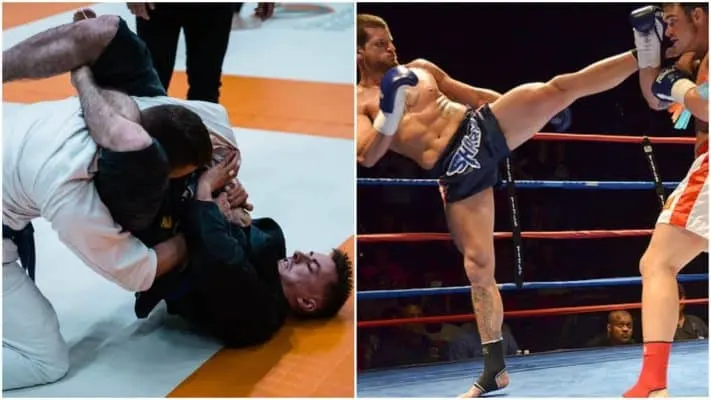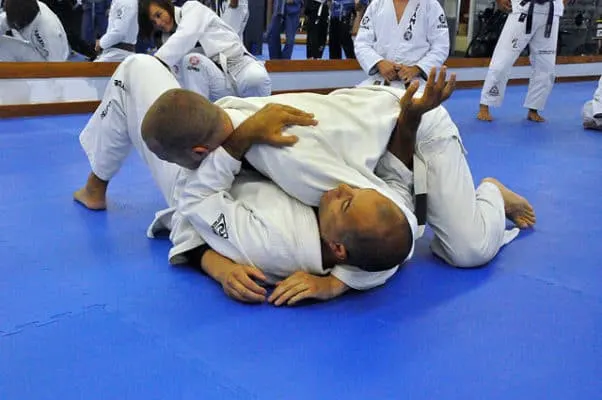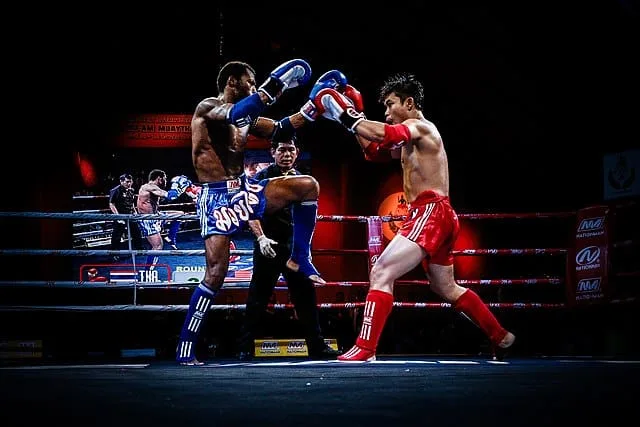
Just about every martial art can fall into one of two major categories. The first group is striking where the most well-known arts are Muay Thai and Karate. The other group is grappling where we have BJJ, wrestling, and Sambo. But the real question is which one between the two is more effective for self-defense, grappling or striking?
Of course, there’s no real data showing which fighting style is more effective for self-defense scenarios. But, we can form our opinion using the results and data from MMA fighting which is a sport where fighters can utilize both grappling and striking techniques.
According to data, most UFC champs come from either wrestling or BJJ. This suggests grappling is a more effective fighting style than striking and there are good reasons for this. Grappling can nullify striking in most self-defense scenarios because grapplers learn how to utilize grappling techniques to counter striking. On the other side, striking arts aren’t designed to stop grappling techniques. Strikers only learn how to fight against strikers so their skills are very limited when it comes to defending against grappling techniques.
Keep reading this article as we will explain to you in more detail why grappling is better than striking for self-defense.
Grappling vs Striking: Which is More Effective in Self-Defense?
Grappling is more effective for self-defense than striking and here is why. A trained striker might be really good at fighting someone their own size in a stand-up fight. But in a street fight, there are no weight classes and you don’t get to choose to fight someone your size. Your attacker might be much bigger than you.
In a striking art, being a smaller fighter can be a major hurdle fighting against a much bigger opponent. A trained striker who is 5’4” and 135lbs, for instance, will have a hard time defending against a person who is over 6’2”, and weighing 250lbs in a self-defense situation. In other words, a small person, no matter how good of a striker, will face difficulties dealing with the power and big disadvantage in size and reach.
However grappling arts differ a lot here as they teach you how to defeat the opponent regardless of their size much more effectively. Grappling techniques can be used to nullify your opponent’s physical advantages by taking them down to the ground using leverage and technique to take the top position to restrict the opponent’s movements.
As a result, your chance of defeating a bigger and stronger opponent is greatly increased when using grappling techniques than striking techniques.
Grappling vs Striking: Which Style is Better?
Keep in mind that when it comes to style vs style, grappling is much more superior to striking arts. Skilled boxers or Muay Thai fighters are not trained to defend against grappling techniques. They only train how to deal with another striker by learning punches, kicks, and other strikes. This is why grapplers can neutralize any striker by taking them down to the ground.
Strikers would have a hard time fighting off their back where they are at a huge disadvantage. They simply don’t know how to use grappling techniques to get back up or defend against submissions.
It would be just a matter of time before a skilled grappler can place a choke or a joint lock to submit the striker.
Striking is good for self-defense as long as you fight on the feet and the attacker is throwing at you. You can use your striking skills to counter their attacks and defend. But in reality, street fights are often chaotic and include a lot of close-range grabbing, pulling, and grappling. This is where boxing or Muay Thai skills won’t help you much for self-defense while BJJ and wrestling work really well in these scenarios.
Grappling or Striking – Which One is More Effective in MMA?
Grappling arts have proven to be more effective in MMA fighting than striking. In the early days and before cross training, MMA fighters were experts in just a single fighting style. We saw many style vs. style matchups in which grapplers were dominating strikers. In fact, over 60% of the fights in 1994 ended via submission which shows you that grappling was much better than striking in the early days. But the game has changed a lot since then as fighters began to cross-train to learn how to fight both standing and on the ground.
As a result, the submission rate in the UFC has dropped down to 21% in 2019 for instance. But this doesn’t mean that grappling has become less effective. No, this is because nowadays more than half of the UFC fights end in a decision, and fighters have become good at defending submissions. But does this make grappling less effective you may ask? Well, the answer is no.
First, takedowns and top control are often a deciding factor when it comes to decision wins. Grapplers are the ones who can dictate the place of the fight by scoring takedowns. And they will take any striker down who doesn’t have good defense without much effort.
The same stands when it comes to top control. Grapplers can use their skills to stay on top of their opponent who has good striking for the entire fight. This nullifies the risk of a grappler being hit by the striker in the standup and allows them to impose their game. And staying on top is also a good tactic to tire the opponent out since fighting from the bottom position causes faster exhaustion.
Even the purest and most skillful strikers in the UFC can’t succeed without learning how to defend against grapplers. Strikers can’t transition to MMA from striking and do well without any grappling training. Just look at how pro-boxer James Toney failed when he decided to test his boxing skills in MMA. But on the other side, top grapplers who came into MMA without any striking have all done quite well by using their grappling skills primarily. Here are some of the best instances:
This shows you that grappling is clearly more effective than striking when it comes to MMA.
And with strikers getting better at defending submissions, grapplers have found a way to win fights via ground and pound. A lot of TKO finishes in the UFC come when a grappler starts raining down punches from the top position using their grappling skills.
Grappling or Striking – Which One is Harder to Learn?
The answer really depends on the type of grappling or striking art we are talking about. It is also based on your talent as some people may have an easier time learning how to grapple than how to strike and vice versa. But overall, we must say that grappling arts tend to be harder and take longer to master.
For instance, BJJ and wrestling are often seen as the best arts when it comes to grappling. They are both very complex, notably the BJJ which is often seen as a “human chess match”. It consists of hundreds of techniques and you need to spend many years working hard on the mats to learn them.
On average, a devoted BJJ student needs around five years of training to become a skilled grappler, and ten years to reach a black belt rank.
This is much, much longer than the time you need to spend in the striking gyms. Of course, strikers like pro boxers or Muay Thai fighters must train from an early age. But an average person needs around 1–2 years of boxing training to develop solid skills and start competing.
Still, we must say striking arts are physically harder on your body when it comes to training and injuries. Absorbing punches, kicks, elbows, and knees on a weekly basis will take a toll on your body in the long run. Strikes simply lead to more injuries than grappling and rolling on the mats.
Should you learn Grappling or Striking First?
This depends on many factors like age, talent for sports, your personal preference, or what you want to achieve. Do you have any intentions to fight in MMA later? Do you like grappling more than striking or vice versa? The best way is to attend a trial class in both arts before making a final decision. Here is our suggestion that might help you make the right choice.
Grappling arts tend to be safer as they do not include any striking so the risk of injuries is much lower in the long run. They are also more complex and harder to master so it is very important to enroll in training as soon as possible. There are hundreds of techniques to master and you will learn and develop skills at a very slow pace.
If we stick with the facts, then grappling should also be your choice if you want to fight in MMA. This is because most UFC champs actually come from grappling arts like BJJ or wrestling. And over the years, having an elite ground game and solid striking skills proved to be an ideal combo of skills. Here are some of the best instances:
Bear in mind that there’s nothing wrong in going into striking first either. The ideal option would be to train in both grappling and striking at the same time since this will make you an all-around fighter. Fighters from both types of fighting styles could improve their game and fill all the holes by cross-training.
Can a Striker beat a Grappler in a Street Fight and Vice Versa?
Fighters from both grappling and striking have all the weapons and skills to beat each other in any type of fight. The winner of this type of matchup would be a fighter who manages to impose their game. But, who would win also depends on what type of fight we are talking about?
If they fight in the open like outside of the bar, in the park, or parking lot, then skilled strikers have a good chance of beating grapplers. They can use footwork to stay mobile and at a safe distance from which they can use kicks and punches to do damage.
For instance, strikes like Muay Thai kicks can generate the same force as hitting a person with a baseball bat. Now imagine what would happen when a grappler, who has never been kicked before, receives one. Or they can catch a grappler coming in with an uppercut or a knee which happens often in MMA. Just look at how Derick Lewis knocked out skilled wrestler Curtis Blaydes if you need an instance.
But bear in mind that grapplers like BJJ fighters and wrestlers also understand the elements of standup fighting. They all have a feeling for distance, how to cut the movement of the opponent, and time their entries on a takedown.
Grapplers have a big advantage if the fight is in a small space or at close range. In this case, strikers do not have enough room to circle around and keep their distance. Once a wrestler or BJJ fighter secures a strong grip, just about every striker would be taken down. And once there, grapplers know how to keep the opponent on the bottom or apply chokes and joint locks.
We would always bet on a skilled grappler to win against a skilled striker who doesn’t have a good takedown defense.
What is the Best Grappling Art?
Brazilian jiu-jitsu is, perhaps, the best and most versatile grappling art. Even though there are many others like judo and wrestling, BJJ is clearly the best. It is good for self-defense, fitness and a great base for MMA fighting.

Photo by MartialArtsNomad.com
Founded in the 1920s by the famous Gracie family, BJJ has its roots in Judo. Since each fight starts on the feet, students must learn how to use throws and trips to take the fight to the ground. The focus of the art is on ground fighting. Students learn how to secure a position, various escapes, sweeps, and submissions to finish the fight.
When it comes to self-defense, BJJ is close to ideal as it is the only art that allows you to beat a stronger, heavier, and taller opponent. You can achieve this by relying on leverage and technic rather than using sheer power. And its chokes and joint locks work the same no matter how big the opponent is. It even doesn’t matter if the opponent overpowers you and puts you in the bottom position. You can still use sweeps, escapes, and submissions off your back to beat them.
Training is great since it’s never too late to start, and it really doesn’t matter if you are male or female. Although the beginnings are always hard, you will have a lot of fun in every class. This is mainly because each class includes a sparring session in which you practice the techniques in live-action with the partner.
Other great grappling arts to consider are:
RECOMMENDED FOR YOU: What is Gracie Jiu-Jitsu? Fully Explained
What is the Best Striking Art?
Muay Thai is, perhaps, the best striking art that teaches you how to use your entire body as a weapon. There are plenty of other great arts like boxing or karate, but Muay Thai might be the best.

Muay Thai is often seen as a complete striking art that will teach you all about striking. Fight experts also call it the “art of eight limbs” since students learn how to use punches, kicks, elbows, and knees. And let’s not forget it also covers the basics of grappling like trips and throws.
The emphasis of Muay Thai is on counter-attacks, landing vicious kicks from distance, and clinch fighting. The entire concept of the art is based on doing big damage and finishing a fight as fast as possible. It will teach you all about hip rotation and how to throw each strike with huge power.
Training is cardio intense and burns up to 1000 calories per hour, which makes it very popular among people who want to lose weight and get in shape. It also includes a lot of sparring which is often seen as the only way you can prepare for real fighting. But this is optional and some people train Muay Thai just for fitness and to improve their strength.
And for last, Muay Thai techniques fit well within the rules of MMA fighting. What it brings to the table are vicious kicks, and elbows, and knees in the clinch. Just about every great KO we have seen in MMA includes some elements of Muay Thai.
In recent times, we can often see MMA fighters finishing a fight using leg kicks only. Look no further from how Dustin Poirier finished Conor McGregor if you need an instance.
